Text
Darksiders II: Deathinitive Edition

Is this game beloved? It is not, right? I mean, I really haven’t heard a ton of people saying that they love this game. Right? Well... I just played it and I gotta say, I really, reeeally like it. It is a solid game, the likes of which seems to me that should have some sort of cult following.
I played the first one way back when it first came out and have been meaning to play this one since it was released. Then the remaster came out and I still skipped it, until now. The game is nothing groundbreaking. Nothing is about it is super unique or revolutionary. And it even has some refinement problems like a few wild bugs and some less than ideal camera work. And still, I had such a great time playing through it, exploring the world, fighting enemies, etc.
Yeah, this is a pretty good game. As I said, nothing groundbreaking, just an honest, solid, fun game that I enjoyed a bunch.
What is it?
So anyway, what is this game about? The best way that I would describe Darksiders II is by saying that it’s a mix of several good things. This is an 3D action adventure game with RPG elements. The combat is just like pre-2018 God of War. It’s got a world structure just like the pre-Breath of The Wild Zelda series. Also like Zelda, it’s got dungeons with puzzles and traps and enemies and the like. Traversal feels like Prince of Persia mixed with Uncharted most of the time. It’s got a progression system based on your character leveling up as he fights and gains experience, like any RPG. And, finally a loot system akin to the ones found in games like Diablo.
Darksiders II takes all these well established gameplay elements and merges them together into a cohesive package that, after summing up all of its individual parts, comes out being something great. In a sense, you could say that this combination is the very thing that makes Darksiders II unique: an expertly executed mix of these specific genres. That could maybe be a little bit of a stretch though, but really, that’s neither here nor there. I don’t subscribe to the belief that a game needs to be unique or have a twist to be truly great and enjoyable. To me, Darksiders II is a validation to that sentiment. This is just a fun game.
The combat
Darksiders II is made up of many parts. All of which I think are well implemented enough. The combat, while not being nearly as deep as something like what the genre defining games like Bayonetta or Devil May Cry have, still feels good and fun. It’s also nuanced enough to keep it from being a mindless button mashing festival. It’s your classic God of War-esque affair of two attack buttons (light and heavy attacks) and a jump button that, when pressed successively in different orders, can produce a variety of combos. That, along with some special items, attacks and buff skills sprinkled in, make the whole combat competent enough.
The level design
The level design of both the over-worlds and the many dungeons are intricate enough so that exploration feels rewarding. The puzzles are a mixed bag that go from just-ok to pretty good. These brainteasers are a good way to take a break from hacking and slashing, slowing things down for a while a bit. Save for a very few instances, they never overstay their welcome.
The loot
Tying back to the rewarding exploration idea that I mentioned earlier is the loot system. Your character can equip multiple pieces of armor and main and secondary weapons. The game world is littered with treasure chests both hidden and in plain sight that contain such items in varying rarity levels, along with healing potions and good old money, which can be used in shops throughout the adventure.
The traversal
Traversal though these these worlds also feels very good. There’s a combination of climbing, wall-running, swinging, wall-jumping and more, that make you feel like a very capable acrobat.
The presentation
All these aspects are well executed in Darksiders II and make for a pretty good game. Where I think it excels though, and is what propels it to the next level, is in the overall presentation. This game looks gorgeous. And make no mistake, this is no technical marvel, but the art direction is so on point that I couldn’t help but stare at times at the architecture, vistas, and the design of weapons and armor which are made with so much intricate detail.
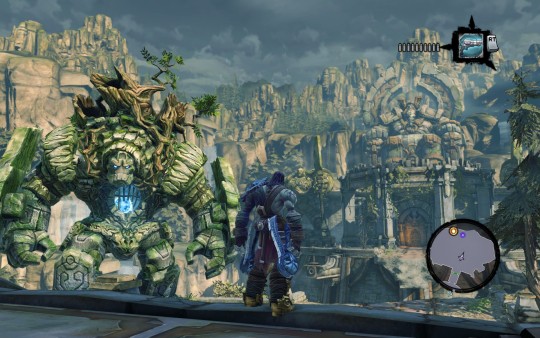
All of this looks so cool.
That said, what takes the cake in the presentation department is the character designs. I feel like all the characters, including the player, NPCs and enemies got a ton of work put into their designs as well as in their realization within the game world. Everyone looks great, from the goat person that sells you weapons to the king of the undead that at some point has you running errands for him. Everyone is so unique, interesting, fun and just... cool. So cool. The voice acting is also great, backed by some excellent writing. Particularly Death, the player controlled character, has some great lines and great deliveries. I’m no writing expert but I found the way people speak in this game so appealing. The words they use, their accents, their voices, everything works together to really sell the high fantasy setting. And nothing feels weird or out of place.
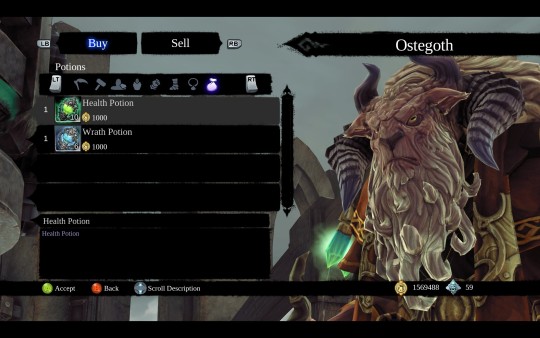
I mean... Look at this guy.
As far as the plot goes, it’s not the most intricate tale in the world. But I feel like it is well executed. In this game you play a Death, one of the four horsemen of the apocalypse, who, after learning about his brother’s wrongful imprisonment, embarks on a quest to redeem him by bringing back humanity from extinction. The story is pretty simple but there are several events that transpire and characters that you interact with during the journey that manage to keep things interesting. That, combined with some good acting and writing, makes the whole thing pretty effective.
Not everything is rosy though, I have two complaints related to game refinement:
1. Bugs. I encountered a couple of weird bugs. Nothing game breaking thankfully. There was a time when the physics engine went haywire and threw me into the sky when I was actually supposed to drop down. Died and had to restart from the latest checkpoint. No biggie, just a minor annoyance. Another issue that happened to me sometimes was that almost everything would go silent and I had to restart the game. I’m talking about most sound effects and background music, gone. Super weird.
2. The camera. The camerawork, overall, leaves a lot to be desired. I feel like the camera could’ve been used much more effectively to highlight some key moments in traversal (like some tricky jumps or swings) and in combat. Which is a shame too, because this game’s animations are so cool and well done. It would’ve been great to be able to enjoy them with a camera that actually made sure we saw them in all their splendor. And this is just camera placement, not bugs with the system per se. I feel like many times the camera was too close to the character or not having the action front and center. A missed opportunity there for sure, but overall it didn’t hamper my enjoyment of the game too much.
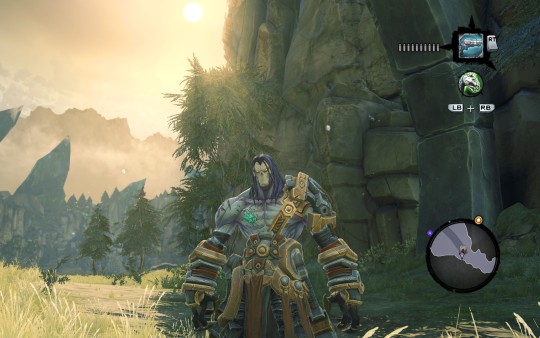
Death is a pretty cool guy
So yeah, that’s my opinion on Darksiders II. In case you couldn’t figure it out, I really enjoyed this game. It is, as I said, nothing groundbreaking as it takes heavy inspiration from other industry heavy-hitters like Zelda and God of War, but it’s still, nevertheless, a super fun time. Would definitely recommend to any and all action adventure fans out there. Looking forward to getting around to playing the sequel soon.
17 notes
·
View notes
Text
Marvel’s Spider-Man
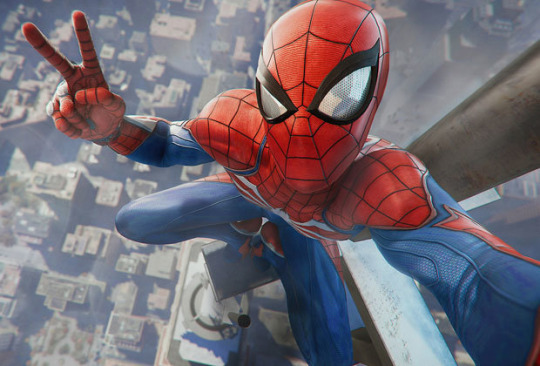
I figure I start most of my blogs with this sentiment but I really can’t help it. After all, I like to write about things that I like. That said...
Wow I love this game. Wow. This is, without a doubt, the best Spider-Man game ever made, and one of the best in the action adventure genre as a whole. And with a great story to boot!
There are three aspects that I want to talk about for this game: movement, combat and story. Spoiler: all three are excellent.
Movement
Coming from Insomniac Games, I sort of expected the traversal be great. I never played Sunset Overdrive but I heard awesome things about how good movement was in that game. I also remember playing the likes of Spider-Man: Web of Shadows for the Wii and Ultimate Spider-Man for the Game Cube. Both are open world games where Spidey’s main mode of transportation, web swinging, felt fairly good. So I figured, yeah, the foundation and all the ingredients are there. We should be in for a good treat.
This game though, it kicks things up a few notches. I honestly don’t how to put it into words. Web swinging in this game feels SO good. It takes a little bit of learning at first, but once mastered, you can zip through roof tops and along buildings with so much ease and quickness. Like Spidey himself truly would.
Traversing the huge open world of the island of Manhattan is incredibly fun. So much so that I almost never wanted to fast travel, which is pretty fun in itself as you see Spider-Man taking the subway and sometimes interacting with other NYC citizens. I sometimes wanted to fast travel only to see these cute interactions, but it was never a necessity. I never cared about saving time because I was never bored of swinging around the city.
There are basically three main of moves to use for traversal. First, there’s your typical, momentum-based-pendulum-trajectory web swinging. This is what you’ll be doing the majority of the time to move from point A to point B and it feels great. Nay, perfect. It truly feels perfect. The senses of momentum and speed make doing this so much fun. Web swinging is realistic in the sense that you can’t just do it anywhere, there must be a nearby, higher point where the web can attach to in order for Spidey to be able to swing. This serves to give you a great sense of place within the world and makes it that much more believable.
At any point along a swing, you can let go of the web to jump off of it. Depending on the point you let go, you’ll be shot straight forward, upward, or anywhere in between. It feels great when you know when to let go in order to make traversal more efficient for your specific destination. Chaining web swings together to get to where you want to go as quick as possible is just a ton of fun.
The second move available for traversal is a web zip that pulls Spidey straight forward. This is very useful when moving horizontally to get sort of a speed boost. You can’t do many of these in succession so the idea is that you alternate it with the regular web swing. In particular, this move becomes a necessity when there are no higher points around you for the web to attach to for a swing.
The last and final traversal tool is another style of web zip. This one, however, attaches to any point in range and pulls Spidey towards it in an instant, regardless of direction. There’s a targeting system as well that highlights these points as you traverse. These points can be the top of a sign, a space that Spider-Man can quickly squeeze through, a building’s roof corner, etc. Pretty much anywhere. What’s important though, is not where this can happen, but the fact that, thanks to the auto targeting system, it can happen at any moment, mid flight. Also, just after landing from one of these web zips, Spidey can jump right away and continue moving forward while gaining some speed.
So, with these three moves, Spider-Man has all the tools he needs to traverse Manhattan quickly, with style and having a ton of fun while doing it. The traversal then, becomes a sort of rhythm that alternates between swings and both types of zips. It is truly a thing of beauty because, it not only feels great, but it also looks awesome thanks to the incredible job that the animators did for this game.
There’s also crawling and running up and along the sides of buildings which, while not as exciting as the previous three moves, can also be chained together in the “traversal rhythm” to produce something truly exceptional. They all come together into what is, in my opinion, one the most fun movement systems in a video game to date.
Combat
The combat is also a highlight in this game. There are punch (or kick, depending on the situation), jump and dodge buttons. It is clearly Arkham-inspired but with a host of Spider-Man inspired twists that make it have its own identity. The combat system in this game is far more dynamic and fantastic that anything you’d see in an Arkham game. There’s a great emphasis on air combat and using the environment and gadgets.
On the ground, Spider-Man plays a lot like Batman. You punch dudes until some dude, by trying to hit you, alerts the Spider Sense, prompting you to dodge, rinse and repeat. You need to be careful about different types of enemies though, as some are immune to certain things. Some guys hold shields, for example, and are only vulnerable by slipping to their back and hitting them there; some others are big brutes that will take some webbing before they can be taken down by hitting them (more on the gadgets later).
The environment is also ripe with opportunities to help mess up your foes. Spidey can pick up stuff like barrels, manhole covers and cement bags that are lying around, swing them with a web rope, and throw them at some dudes. The dudes themselves, once incapacitated, can also be swung around with webbing and thrown at other dudes. You can also take the weapons (bats, rifles, bazookas, and the like) from said dudes hands and throw them back at them. Oh, and if you’re close to a wall, Spidey can quickly jump and stick to it to then spring back with a punch! It’s all incredibly fun.
When fighting groups of enemies, you’re encouraged to lift them off the ground whenever you can with a well placed uppercut. Once in the air, enemies can be comboed, thrown away, smacked back down to the floor or brought back up for more punishing. This is not endless though, as Spidey will lose altitude gradually until he’s back on the ground.
Spider-Man also has many gadgets which have been implemented in an awesome way. There are web bullets, web bombs, web mines, impact webs and even a flying spider that shoots lasers to the thugs. Just thinking about it while writing this brings a smile to my face. These gadgets can be upgraded individually by spending tokens that you earn as you progress through the game.
Oh! And there are even stealth sections which also feel great. There are few things better in life than being Spider-Man sneaking around and dispatching thugs without them even noticing it. Simple pleasures.
Anyway, the combat system is also a home run. It’s so much fun. It can also get pretty difficult at times when the game throws many enemies of multiple types and weapons at you in a single group. It all adds to the excitement and fun. Another point that I like is just how true to Spider-Man the combat feels. It’s all just punches and kicks and gadgets and throwing people and stuff around. But it’s all so fluid and acrobatic and dynamic and well animated. It truly looks like this is how Spider-Man would fight.
Story
This is one aspect of the game that caught me by surprise. Honestly, I think this game’s story rivals that of any of the movies and, in some aspects, maybe even surpasses them. In that sense, I feel like, not counting the comics, of which I’m no expert, this is one of the finest Spider-Man stories ever told. The campaign in this game is exciting, emotional and cool. It brings together familiar elements of the Spider-Man ethos, but also is not afraid of shaking things up a bit. The characters, both new (to me!) and old, are charming, engaging and I ended up caring about them and what they go through. Both villains and good guys. I don’t want to say anything more as I don’t want to spoil anything. Just go ahead and play the game.
What else can I say? Well, actually, I can still say much. I can talk about how good the score is (I’m actually listening to it right now as I write this), or the collectibles, or the suits, or some of the side quests. But I think by now I’ve gotten my point across. This game is great, a masterpiece even. I think that any fan of Spider-Man or video games in general should try it out.
2 notes
·
View notes
Text
Wolfenstein The New Order + The Old Blood

After having a blast playing the incredible 2016 reboot of Doom and hearing marvelous things about the latest Wolfenstein game, I figured out I should give the first one a shot. So I did, and I loved it.
The New Order
Wolfenstein is an incredibly fun, action adventure first person shooter with great action and cool weapons. The levels, I found, are structured a bit more linearly than Doom’s. However, they still lend themselves for a good amount of exploration. The game rewards this exploration with cool secrets and collectibles, as well as documents that flesh out the world by letting you in on some of the lore.
And speaking about lore, the game takes place in an alternate version of our world where Nazis won the second world war and rule over everyone with an iron fist. These documents that you find throughout the levels are often newspaper articles that describe how pivotal events of this world’s Second World War played out. Some describe how the Nazis betrayed some of their fellow Axis powers members; while others go into detail on how certain Allies countries are faring in this world or how they were defeated or surrendered. USA, for example, surrendered when an Atom Bomb was dropped in Manhattan.
Not only that, but the levels are also packed with Nazi propaganda, chatter among soldiers, etc.
All of these serve to give the levels a sense that they belong in a cohesive and believable world; and definitely got me more invested in the narrative. I think this is a very interesting realization of a world where Nazis won the war and rule everything with an iron fist.
So how did the Nazis win the war? Well, without spoiling too many details, the Nazi war machine gained the upper hand over the Allies thanks to the inventions of one talented and unscrupulous scientist by the name of Dr. Wilhelm Strasse (affectionately also known as Deathshead). Strasse is the main antagonist of the game and, thanks to the terrible weapons he developed, a key protagonist in the Nazi’s rise to power.

With stuff like this, no wonder the Nazis are winning the war.
We play as William Joseph "B.J." Blazkowicz, a tough-as-nails, no-nonsense US military soldier who, at the beginning of the game, already has a grudge against the good doctor. So, for Blazco, this is not only a fight for the freedom of the world but also a personal one.
The campaign in this game hits several notes: there are heart pumping action moments, slower paced exploration segments to cool down, tension heavy stealth sections (which are optional, as you can choose to go in guns blazing anytime), and cool enemies and boss fights.
About that last point of cool enemies and bosses, I particularly like how the lore has a synergy with the actual gameplay to produce good enemy variety: thanks to Deathshead’s inventions, Nazis now rule the world, so it makes sense that BJ faces all manner of terrors in the form of killing machines and mutants.
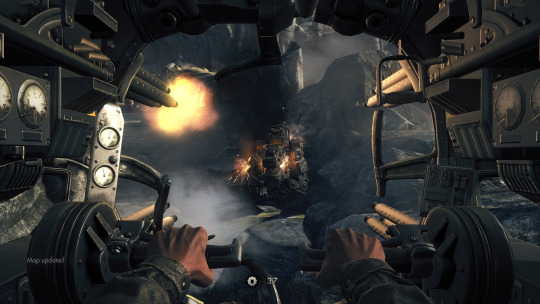
Yup, it’s a mechanical dog eager to have BJ for breakfast.
I also like a lot the fact that the levels are well designed enough so that they allow for multiple strategies while playing them. You can approach each mission from very stealthy, to a full on frontal assault, to anything in between. Any of them feel like fun, viable and well realized methods for going through the game.
Now, the game is structured in a campaign, of course, with multiple missions/levels. The only twist to the formula is an alternate timeline thing that you trigger in the first mission of the game by making a decision. There are two possible timelines which are pretty much identical. The only differences are slight variations in the cast of characters as well as access to certain collectibles. Specifically, there are four characters that are exclusive to timelines: two in one and two in the other; and, in one timeline you can get health upgrades while in the other you can get armor upgrades.
Overall, I found the whole alternate timeline thing to be pretty much pointless and unnecessary, as I believe the main aspects of both could’ve been merged together perfectly in a single timeline.
There’s one aspect though that I liked about this two timelines situation: It gave me an excuse to play through the game twice. As I said, there are some collectibles that are exclusive to each timeline, but really my main reason to do it was that the game is just too much fun. I just wanted more. Also, it helped a lot the fact that you can be stealthy in this game. Playing twice allowed me to go through it in two different styles: during the first play-through I did as much stealth as possible, while, on the second, I went in guns blazing almost always. I had great fun doing both and I honestly can’t say which one was my favorite. I really liked both.
Also, the change in cast was a big plus. Gameplay wise this game is masterful but the story and characters doesn’t fall far behind. It was a treat to see the few new timeline-specific characters in action. All of them were different but great in their own right.

Dual wielding assault rifles and unloading in a Nazi robot of death... One of life’s simple pleasures.
What about game mechanics? Well, this your typical, fast paced first person shooter. BJ has access to several weapons that each feel unique and are fun to use, which he can also dual wield (YES!). All of the weapons also have alternate firing modes. For example, the pistol can have a silencer attached and the assault rifle can turn into a grenade launcher. There’s good variety here. We’ve got the classics like grenades, pistols, shotguns and assault rifles, which all feel great. And we also have more esoteric stuff like a laser cutter that serves for traversal by cutting through sheet metal. It’s typical, yes, but everything feels smooth and the controls are tight. It’s just a good, solid FPS experience.
The Old Blood
The DLC for this game is very straightforward. A series of missions that serve as a prequel to the events from the main game. You play as Blazco again, but the cast of supporting characters is all new.
Here, we see BJ, just a few days before the beginning of The New Order as he goes undercover into a Nazi stronghold, Castle Wolfenstein, along with fellow operative Richard Wesley, with the objective of obtaining some intel on the location of Deathshead. Things however, turn south quickly and BJ has to fight for his life and uncover a mystery more sinister than he could’ve imagined.
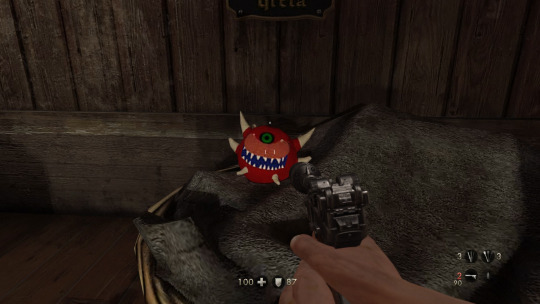
What does this mean? Doom and Wolfenstein exist in the same universe?
Pretty cool premise and a great excuse to jump back into Wolfenstein. To put it simply, this DLC is just more of the same. This is the same framework but with a new story, new characters, new levels, new enemies and new weapons. But in this case “just more of the same” is great and I wouldn’t want it any other way. That’s all because the gameplay foundation and premise for this game are so very strong.
Overall, I feel that this campaign is not as strong as the main game’s, but it’s still a worthy addition and a joy to play through.
Final thoughts
Yeah, this game is fun. I really like this breed of fast paced, adventure-and-exploration-heavy first person shooters with over the top action like Doom and Wolfenstein. Wolfenstein however, one-ups Doom in the story department with great plot and characters. I had great fun playing this game and its DLC and I’m glad I did’t just skip it to go straight to The New Colossus.
#wolfenstein#the new order#the old blood#first person shooter#bethesda#machinegames#doom#videogames#video games#acrion#adventure
0 notes
Link
0 notes
Text
Bloodstained: Curse of the Moon
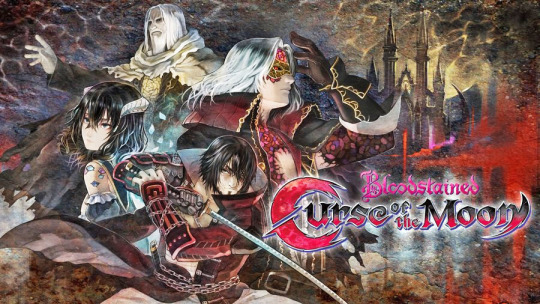
I truly love Castlevania, both the newer metroidvaina style games as well as the classic interpretation (albeit to a lesser extent). Although I haven’t played the second part yet, I even have some love for the latest 3D outings like Lords of Shadow.
Naturally, when I learned that mister Igarashi was building a brand new game in the style of Symphony of the Night, I was exited. I’m looking forward to Bloodstained: Ritual of the Night but things got better when, with the help of Inti Creates (from Mega Man Zero fame, which I love as well), IGA and team released Bloodstained: Curse of the Moon, as a smaller appetizer.
This game is very different than RotN. As far I understand it, story wise, it serves as a sort of prequel to the main game. Also, this game is in the style of classic 8 bit Castlevanias like the first and third (Castlevania III: Dracula’s Curse) ones, both in structure and visuals; while Ritual of the Night is a modern looking metroidvania.
As far as classic Castlevania goes, I think this game is pretty much perfection. It has all the design elements like hard difficulty, various sub-weapons, slow and deliberate movement and attacks. Much like Castlevania III, It also has four playable characters that the player can switch at any time during a level. Each level also has multiple routes and secrets to uncover. These are often only accessible by one specific character.
All of these features, along with expert level design, tight controls and fun boss fights, come together in a package that, In my opinion, not only breathes new life into a style of game that we haven’t seen in a long while, but also surpasses the games it took so much inspiration from. It learned from the classics and improved on them without deviating too much from the path established by them.

The bosses are a ton of fun but you gotta have some suspension of disbelief... How’s that puny sword gonna do anything against that monster?
I had a ton of fun playing this game. So much so, that I ended up playing through it four times back to back. The game encourages you to do so as there are multiple endings and ways to play it. And this is the part where Curse of the Moon deviates from what the classic games established and offers its own twist on the genre.
1st Playthrough (Normal)
Here’s how it works. You start the game as Zangetsu, a typical samurai-ish Simon Belmont type that walks and jumps and uses a katana to attack. The katana is a pretty low range weapon (meaning you have to get pretty close to enemies to attack) and, as such, you will need to use your sub-weapons (that are collected throughout the levels) for much needed versatility. As you progress through the game as Zangetsu, you’ll unlock new playable characters.
First of all is Miriam, she’s the protagonist of the upcoming game. Miriam walks at the same speed as Zangetsu but can jump higher. Also, Miriam uses a whip as her weapon of choice which, even though it’s a bit slower than Zangetsu’s katana, it has much more reach. Also, she has access to a distinct set of sub-weapons. Actually, every character has their own set of sub-weapons. This adds to their variety and uniqueness.
After Miriam, you unlock Alfred. He is an alchemist whose main gimmick is that his normal attack is pretty much worthless as he uses a magician’s rod with pretty much no reach or speed. Where this character really shines is with his sub-weapons. For Alfred, every sub-weapon is a different spell. We’ve got good variety here. There’s an ice lance of sorts that is thrown horizontally in front of him and freezes everything it touches. This turns enemies into platforms and also allows one to kill them in one hit, as the ice shatters. There’s also a series of fire balls that surround the player offering protection from most ranged attacks as well as consistent damage if you get close enough to an enemy. There are also a few more spell types that Alfred can use but you get the idea. These offer great options for dispatching enemies and defending, but also serve for exploration when, for example, a frozen enemy can be used as a platform to reach previously unreachable places. Of course, these spells are not unlimited and, as any other sub-weapon for other characters, there’s a meter that’s depleted each time you use one of these attacks. Luckily, this can be easily replenished from enemy drops and breaking stuff (like candles!) throughout the levels.

This is a mini-boss of sorts and Alfred just one-shots it.
Finally, the last character to unlock is Gebel. He’s an Alucard type dude that attacks by spawning three bats in front of him that move in a curved trajectory upwards. Gebel can’t use any sub-weapon but has the ability of turning into a bat. In bat form, Gebel can fly and reach places that would be impossible for the other characters to reach. While in bat form, he can also move quickly in any direction by doing a sort of charge attack.
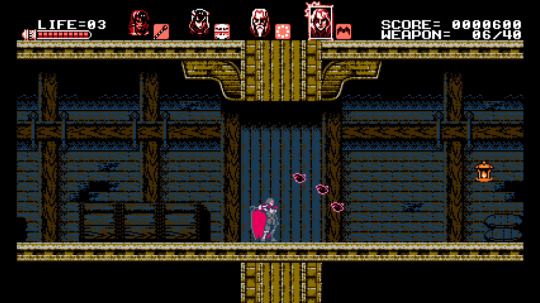
He shoots bats... Yup.
All these characters are unlocked during the first three levels of the game. After that, it’s just a matter of using their abilities to clear the rest of the game’s levels and bosses. Pretty standard stuff but it’s a ton of fun.
2nd Playthrough (Nightmare)
After beating the game for the first time, you unlock Nightmare mode. In this mode, you are able to play as the three unlockable characters from the beginning of the game. That is: Miriam, Alfred and Gebel. No Zangetsu though. Other than doing it just for fun, and for the harder difficulty, there are three aspects that make this playthough worthwhile:
1. Having the extra characters available from the beginning of the game means that, now, you can explore new routes through those first three levels. These are routes that weren’t available during the first playthough because you didn’t have access to the character that would have been able to access said route.
2. There’s an additional final level that wasn’t present in the first playthorugh as well as a new final boss.
3. There’s a different ending.
3rd Playthough (Normal again)
After beating the game a second time, one unlocks nothing. However, there’s another way that one can play through the normal mode which will result in a different ending and overall experience.
How to access this? Well, kill your companions instead of recruiting them. Yup, Zangetsu can become a major a-hole and choose to kill the unlockable characters instead of recruiting them. Other than not having those characters available, the main change that this way of playing the game brings to the table is new abilities for Zangetsu. So, each time you kill one of your would-be comrades, Zangetsu gets an ability from them. Miriam gives him the ability to perform a far more effective and longer reaching jump attack; Alfred allows him to double jump and, finally, Gebel unlocks a dash move where Zangetsu will briefly run forward (or endlessly, if you keep pressing the button).

Hell yeah!
So, yeah, being a jerk pays off and Zangetsu becomes a lot more powerful. And a whole lot more fun to play as well. These new abilities change the game drastically. They turn good-old tank guy Zangetsu into a speedy ninja dude that jumps around, moves quickly and rains death from above. I really like how these abilities mix up the gameplay and makes everything much more fun, fast and flashy.
Finally, there’s a different ending and a new unlock for beating the game this way: Ultimate mode.
4th Playthrough (Ultimate)
Ultimate mode is basically normal again, but with a twist: Zangetsu retains all his powers from killing his associates. This means that you have access OP, ninja Zangetsu as well as the rest of the characters. The game is harder for sure in this mode but it doesn’t matter. By now, you should know the game pretty well and your party is just too strong.
But that’s not all, there’s also a new ability for Zangetsu: he can now charge up a sword attack and deliver a devastating blow that’s both stronger and farther reaching.
Playing the game in this mode is incredibly fun. New abilities, all the characters and the fact that, by now, you know the game pretty well, makes things move very quickly and, again, flashy.
Final thoughts
I’ve had a blast playing this game. It is one of those rare cases where the more you play, the more fun it gets (tangent: Resident Evil 4 will always have a special place in my heart for doing this beautifully with it’s new game plus implementation). This is because it’s not just the simple of repetition running through the same game again and again, but it truly makes an effort to mix things up and introduce new mechanics and tweaks to keep things new and fresh.
If Curse of the Moon is any indicative of the quality that Ritual of the Night will show, I can’t wait any longer.
#bloodstained#curse of the moon#bloodstained curse of the moon#castlevania#igarashi#koji igarashi#inti creates#igavania#metroidvania#castlevania welcome back#nintendo switch#retro gaming
0 notes
Text
Bravely Default

I haven’t really played a huge ton of JRPGs but I have really liked most of the ones I’ve played. The usual classics like Chrono Trigger, Final Fantasy IV, VI and VII are near and dear to my heart. Because of that, I’ve always been interested in playing Bravely Default. When I first heard of this game, I was expecting a classic JRPG with some tweaks to make the experience more accessible for a modern audience. Well, I finally got around to playing it recently and I gotta say, I got exactly what I was expecting and then much more than that.
Improvements to the classic JRPG formula
This game is a classic JRPG through and through, but with a ton of quality of life improvements. For me, there are three of these improvements that are particularly great:
Adjustable random encounters rate (you an even turn them off completely)
Adjustable battle speed.
Auto battles.
These three serve to alleviate most of the frustrating parts of the JRPGs of yore.
Random encounters, for example, can sometimes be really offensive. They can constantly interrupt your exploring of a complex dungeon or your escape from it when low on MP and/or health recovery items. In this game, you can just turn them off for a while until you can heal or find what you were looking for.
Also, another controversial part of JRPGs is grinding. With the adjustable battle speed feature, combined with auto battle (which makes the characters use the last used commands automatically) this process becomes much quicker and easier. So, whenever you feel under leveled and need to grind it out for a few additional levels, Bravely Default gives you the tools to do this: just turn up the battle speed and set it on auto.
After playing this game, I think all JRPGs should include these features from now on. They are just too convenient.
A super fun job system
Bravely Default’s character progression system is very fun and, at it’s core, there’s a masterful implementation of a job system.
First of all, there’s the usual character level, which increases through gaining Experience Points by fighting enemies. Each time a certain amount of Experience Points level is acquired, the character’s level will go up, which will increase their base stats. The base stats are things like Strength, Vitality and Intelligence.

A BUNCH of Jobs to pick and choose from
Then, there’s each character’s job. There are several available jobs which become unlocked one by one as you progress through the game. There are the usual suspects like Black Mage or Knight, but there are also less traditional ones like Salve-Maker or Spiritmaster. Each job comes with it’s set of advantages and disadvantages. Once you assign a job, four main things happen to a character:
Their clothing changes to represent the current job.
Some of their base stats are strengthened and some are weakened, depending on the specific job.
They gain access to that job’s set of active skills through in-battle commands.
They are assigned a “Specialty” which is nothing more than one the current job’s passive skills that character gets for free.
Every character also has a job level for each particular job. This level is also increased by fighting enemies. Every job, as it levels up on a particular character, provides that character with skills which can be active (triggered by battle commands) or passive (named “Support Abilities” in the game) (triggered on their own by special conditions).
In addition to that, a character can be assigned a secondary job (through setting up their “Job Command”). A job set as secondary will only grant that character the active skills of that job. So, secondary jobs have no effect on appearance or stats.

There’s a ton of options for character customization
As for Support Abilities, after unlocked (by leveling up jobs), they need to be equipped. You can equip any Support Ability of any job that a character has learnt, regardless of their current primary or secondary job.
Also, it’s important to note that there’s virtually no penalty for changing jobs whenever you want. This is because jobs do not affect a character’s stat growth. Base stats grow independently from jobs. What the job does is only improve on them when it is assigned to a character. This means that, for example, you can have one of your characters be a White Mage (which favors the Intelligence stat but detracts from Strength) from level 1 until they reach level 10. After that, you can freely change them to Thief and the stats will just be adjusted according to the job. The only caveat is that, when changing to a job for the first time, it would be job level 1. So, to continue with our example, if your level 10 character is a level 5 White Mage, by changing to Thief, they will become a level 1 Thief. This means that they will not have as many skills as when they were a White Mage. Also, as job level increases, the effect that job has on character stats intensifies, which means that they’d also lose on that, until they level up as a Thief and get back to the same power that they had as a White Mage. This also means that, for example, a level 10 character who is a level 5 White Mage will be less powerful than another character who is level 10 as well but is only a level 1 White Mage. The second one will not only have access to fewer skills but also their stats wont be as strong for the job.
Woah! That was a lot! Bravely Default has a pretty comprehensive and highly customizable job system. But, once you figure it out, you can come up with a myriad strategies mixing and matching characters, jobs, passive and active skills. Maybe one of your characters will have a killer move. Or maybe it would take a setup of various characters to pull off. Because there are so many options, it’s very satisfying to figure these things out and come up with a winning strategy.
The game’s title is not just nonsense
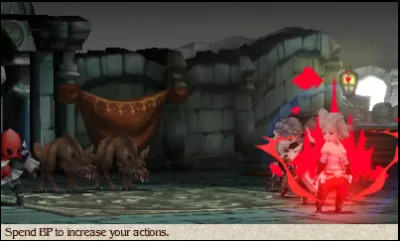
“Braving“ is pretty useful to quickly dispatch common enemies
Finally, there’s the titular mechanic of the game: the Brave and Default system. Basically, with Brave, you can choose to take multiple actions during a turn while not doing anything on the next few ones (depending on how many times you choose to Brave). Effectively “borrowing” future turns’ actions. Default on the other hand, allows a character to defend to accrue a Brave Points. The more Brave Points you have, the more you can Brave. Everyone starts a fight with zero Brave Points. It’s a neat little system that has profound implications in the game. For instance, it can make battles with smaller enemies that much quicker, as you can just Brave the maximum amount of times (which is four, regardless of the current Brave Points amount) with all characters and get rid of them in one single turn. Now, if they are not defeated completely in that turn, be ready for a world of hurt since you’ll be sitting ducks during the next few turns, while your characters pay for those turns they borrowed.
Boss battles become exhilarating also, where you have to manage your Brave Points and choose carefully when to defend and when to go all out with a devastating combo of attacks that will leave you defenseless later, and probably could cost you your party’s life.
That’s a ton of nuance to a game play experience that looks on the surface just like your typical turn based RPG.
A good story
On the surface, the premise is deceptively simple: four young people embark on a journey to cleanse the world of darkness by restoring four elemental crystals. This as classic Final Fantasy as a story can get. However, as things advance, the many layers of characters and the world they inhabit are gradually uncovered to culminate in an epic tale full of emotion, hardship and self discovery.
If I had to criticize one aspect of the game, it would be an event that happens roughly around the middle of the story. At this point, the pace comes to almost a screeching halt where you are forced to traverse the main dungeons and core story line of the game several times with little to no change. Ultimately, I can see what they were trying to do here, it makes sense within the context of the story that’s being told and new details (and a twist!) do get slowly revealed little by little. However, some part of me can’t help but think that this repetition could have been trimmed down a tad and the story made more compact as a result. It somewhat feels like unnecessary padding to me. Still, overall, the tale managed to captivate me and get me invested in the characters and their ordeal.
I really liked this game. The biggest highlights for me are the story, the job system and the quality of life features like control over battle speed and random encounters frequency. After finishing it, I want to play the sequel right away.
1 note
·
View note
Text
Bloodborne: Fear the old blood
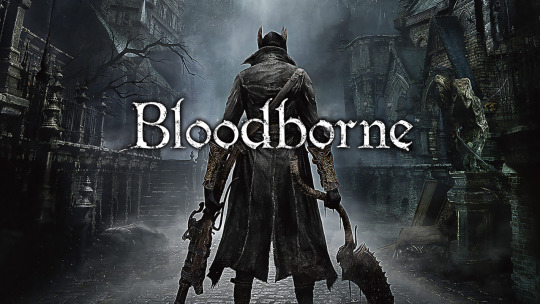
I wholeheartedly believe that Bloodborne is one of the great games of our time. The gameplay is exhilarating, the level design is pretty much perfect, the visual style is gorgeous and unique, and the world and story are captivating.
The Gameplay
The first thought that came to my mind once I finally finished this game was “this feels so much more different than Dark Souls than I thought it would”. And it all comes down to the combat.
On the surface, one could be fooled into dismissing Bloddborne just as Dark Souls, but with a Lovecraftian skin, instead of the usual high fantasy affair. That is far from the truth. While it’s clear that Bloodborne is very similar to its predecessors in difficulty, storytelling style and level design; other than the theme, the overall feel of the game is very different. In Bloodborne, the combat is much more fast paced and frenetic... More aggressive.
While in Dark Souls, fights are very deliberate, strategic affairs where one goes to fight seemingly insurmountable odds with shield and sword in hand, looking for openings to strike and balancing offense and defense; in Bloodborne, things are much faster. Quick dodges and attacks are encouraged. There’s no shield anymore, and in their place are firearms that, in spite of not yielding any considerable damage, are incredibly useful because they serve both to harass foes and to stop them in their tracks to set them up for parries. There’s also what they call a “rally” mechanic, in which the player can recover a small amount of lost health if they counter attack an enemy within a small window of time after being hit.

The beasts are deadly, but a Hunter is a Hunter
To the unsuspecting eye, these may seem like minor changes but, in reality, they alter the flow of combat considerably. As the player is equipped with these tools focused on fast reaction, so are the enemies much more violent and relentless. Timing is key for both dodging and attacking and, more often than not, a more offensive strategy and getting right into the beasts face will result in more positive outcomes than trying to defend too much or keep ones distance excessively, waiting too long for an opening.
All of this makes the player feel much more aggressive and in agency of the adventure. In Dark Souls, I always felt like I was the victim. Pretty much defenseless against a world that’s out to get me; to prevent me from reaching my goal. Night and day difference compared to Bloodborne. Here, I was a Hunter during a night of the hunt, the enemies were not an obstacle but the goal itself. It was my objective to go out there and clean up the streets, kill beasts, end The Nightmare. And I had the means to do so, both in terms of equipment and skills. The Hunter feels much more deadly, much more capable and competent. In Dark Souls, I was the hunted, in Bloodborne I was the Hunter.
This is not to say that the game was easier by any measure. I still got my ass handed to me more times than I could count. But the overall game just felt more like that, and I always came back for more.
The Story
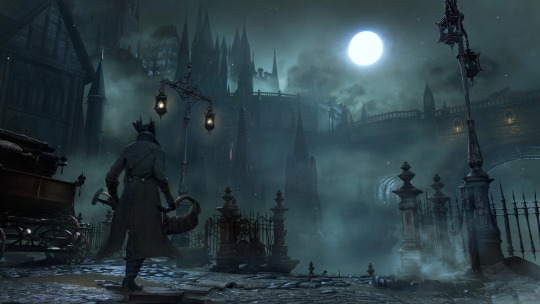
“What a mess you've been caught up in. And tonight, of all nights”
The story is a mixed bag for me. Not because of the events that transpire in the story itself, but because how it is presented. Much like it’s predecessors, Bloodborne’s storytelling style is very lore heavy. There is nearly no exposition at all, there are but a handful of cut scenes, and very obtuse, incomprehensible cut scenes at that.
While I played the game, most of the story bits flew right over me. It was only after I finished the game, when I started doing some research on the matter via online wikis and videos (this guy is particularly great), that I was able to put together the story and world details and learn just how macabre, tragic and interesting a story this game tells. Which is where I’m torn on my feelings over this:
On one hand, it feels to me, like a missed opportunity. This is such a great and intricate story, taking place in such a rich world, that it’s a shame that it is all covered up behind a veil of obscure nonsense.
On the other hand, I’d be lying if I said I didn’t enjoy the experience of getting bits of lore from item descriptions, the world and whatever character dialog was to be heard; and then going elsewhere (i.e. the wiki) to figure out the real meaning (and even theories!) behind everything.
It’s definitely a different style of storytelling, one that, while I don’t prefer it over a more traditional, straightforward one, I can still appreciate and enjoy. One could even say that it fits the game, given its theme of uncovering the cosmic unknowns from ancient, superior beings. All in all, the story is in there, somewhere... But, much like it does the Hunter, it takes some insight to be able to discover it.
Other things to mention
This game has pretty much perfect level design. I particularly love how interconnected the world is, not only between different areas but also each of area within themselves. This is something that can also be said about the original Dark Souls, but I feel like Bloodborne took it to the next level. The various levels feel so dense and intricate, and the expertly placed shortcuts are just icing on the cake. Those feel like true rewards for exploring and advancing through a particular level. They feel earned too, as they are normally placed after particularly difficult encounters.
Visually, the game looks gorgeous. Not only technically but the art direction as well. Even though this art is not completely original, as it was heavily inspired by Lovecraftian horror, I can’t think of any other video game that uses this style, let alone one that has been able to implement it so beautifully.
And that’s it. I’m in love with this game and its world. The gameplay is so good I can barely stop playing. 10/10 masterpiece.
#bloodborne#dark souls#playstation#ps4#from software#video games#videogames#if they show bloodborne 2 in e3 2018 i'll do a backflip
1 note
·
View note
Text
Castlevania: Lords of Shadow
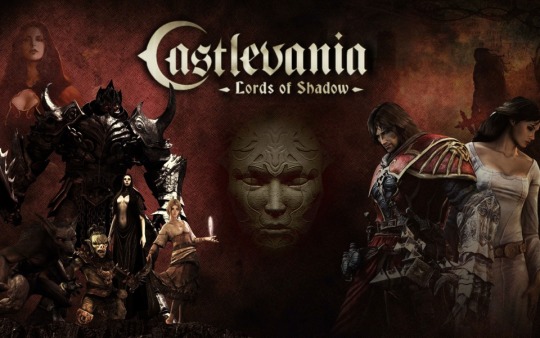
I love Castlevania. I’ve recently played most of the games in the series and have enjoyed them greatly. Lords of Shadow has always intrigued me, but now that I have actual real experience with the series, I knew I had to move it up my backlog.
Here is a game sporting the name of one of the most legendary and long lived video game franchises and yet it has very little to do with the games that came before it. Instead of the series’ now classic 2D-platformer-action-adventure-RPG style, this one is straight up a 3D action-adventure hack and slash game à la God of War or Devil May Cry.
Also, there’s a completely original story that reboots the series and has nothing to do with the lore and events that have transpired during the series’ history. There are certain nods to the old games for sure. We sill play as a Belmont; and the theme for enemies and locations is similar. We still have demons, vampires, werewolves and all manner of creatures of the night. Other than that, however, this is a completely new world with new characters, lore and plot.
Well, it may not be classic Castlevania but that doesn’t mean it can’t be a good game... Well I think that’s true and, overall, I found this to be a pretty good, albeit flawed, game. Let’s get the bad stuff out of the way first.
The bad stuff
This game has many flaws gameplay wise. I think the most egregious one is the extensive use of invisible walls. At the earlier parts of the game, if felt like almost everywhere I tried to go there was an invisible wall. There was so much restriction of movement. That was beyond frustrating to me. And I never care too much, let alone complain, about things like these in games. But here, I felt it was just too much.
The worst part is that most of them are located in places where there’s no visual cue whatsoever that would tell you you can’t walk or jump through. I would go as far as to say that some places were even inviting until you tried to go through and hit the damn wall. Anyway, the good thing is that this problem gets so much less severe as the game progresses. I don’t know if it was just me getting used to it but later in the game these issues were basically all but gone. Those early levels though... Ugh. Not a fan.
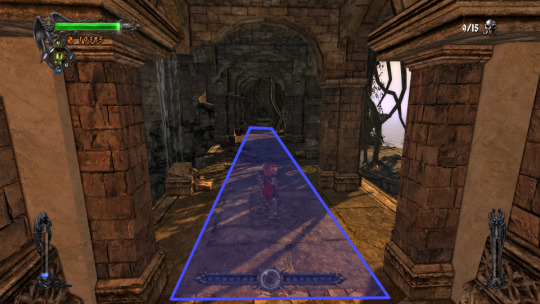
In this corridor, you can only walk over the blue area :(
The invisible walls problem is part of a bigger issue of the game not effectively communicating what actions the player can and can’t do at any given moment. This is specifically apparent with the rappel mechanic, where you are always able to climb up and down the rope but only sometimes you can and run along the wall to the left or right in a sort of swinging motion. The game never tells you or lets you know when you can and when you can not.
Also, another part that I really found troublesome was the camera work. This game is a 3rd person action game but you can’t freely control the camera. The camera is always fixed and, as you move from scene to scene it moves around. Sort of like classic Resident Evil (1, 2, 3 and Code Veronica) where the camera changes as you traverse corridors and rooms. The difference is that Resident Evil had pre-rendered backgrounds and system limitations that the developers had to deal with. I don’t understand why a 3D action game from last generation would decide to go with a camera design like that. Anyway, that’s beside the point. To be fair, games like Devil May Cry and God of War (games from which Lords of Shadow borrows a lot in terms of game design) also use this style of camera. The problem here was that sometimes I felt it was disorienting, prompting one to get lost in some of the more intricate levels. I don’t want to make this sound like it’s a big deal though, because it’s not. It’s nevertheless, something that bothered me from time to time.
The good stuff
Despite its (sometimes infuriating) flaws, I ended up greatly enjoying this game. I think the aspect where this game excels the most is in its overall presentation. The game looks truly great with gorgeous vistas and flashy special effects. There’s also great variety in environments: we’ve got swamps, towers, lost cities, caves and everything in between. The overall art direction is incredible, from the characters to the enemies to the levels. Everything looks beautiful.

Oh yeah take it all in.
Even the menus look great. The menus in this game are stylized as a book that you use to look up things like attack combos, enemies descriptions and weaknesses, weapons, sub-weapons and other collectibles. Everything is accompanied with some beautiful hand drawn art. For the combos, there are even small hand drawn animations that show Gabriel (the protagonist, who you play as) performing them. An overall a great execution.

The art in these menus is beautiful.
I specially like how much care was put into building the world. Not only are the characters expertly designed, but there’s also lore that further enhances both the world and the game’s plot by shedding light into how things are and how they used to be in this universe. It certainly looks like the developers put a ton of effort in building a strong foundation for a new series mythos. I think they succeeded in that.
Also the game’s plot itself is pretty enjoyable. With fun characters and situations and good twists and turns.
In terms of game mechanics, the game is your typical God of War-esque, action affair. There are weak and heavy attack buttons that when pushed repeatedly chain together into various combos that you unlock as you progress trough the game and get stronger. There are two types of magic: blue and red. Using the red one makes you hit harder while the blue one replenishes your health with each hit. These are expendable resources, so managing them smartly is in your best interest. Also, there’s a focus mechanic that kicks in if you fight without getting hit for a while. This makes enemies drop magic replenishing items which you need to chose if it goes to the blue or the red magic.
There are also your usual dodge, block and counter mechanics. Counters are interesting. They are performed by blocking at the last minute before getting hit. Successful counters are rewarded by a boost in focus, but getting hit makes one lose all of their focus. This introduces a nice risk vs reward mechanic because you need to decide if you want to risk getting hit by trying to counter instead of just dodging.
All of these together make for a level of strategy that results in a game that rewards finesse, preventing the battles to degrading into mindless button mashing.
The combat system is pretty interesting overall. Just complex enough to have a good time but not be overwhelmed. It truly shines with some of the game’s most inventive bosses and enemies that put your skills to the test. Not everything is flawless here though as some of the bosses are just plain cheap making for some frustrating difficulty spikes. Other are just plain boring. Luckily most of them are pretty fun and unique.
At the end of the day, in spite of its flaws, I really enjoyed Castlevania: Lords of Shadow. It’s a beautiful looking game with some pretty cool environments and a fun combat style. It even got me interested in playing the sequel.
5 notes
·
View notes
Text
Gunpla Chapter 2 - High Grade Zeta Gundam
Believe in the sign of Zeta.


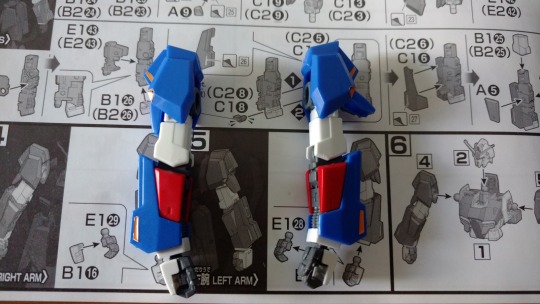

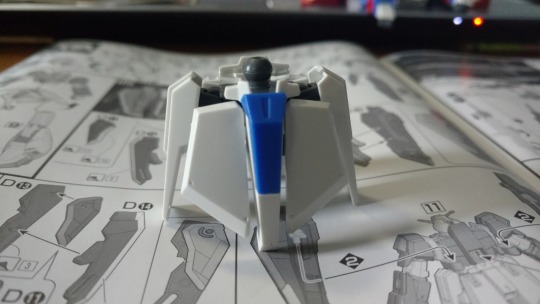

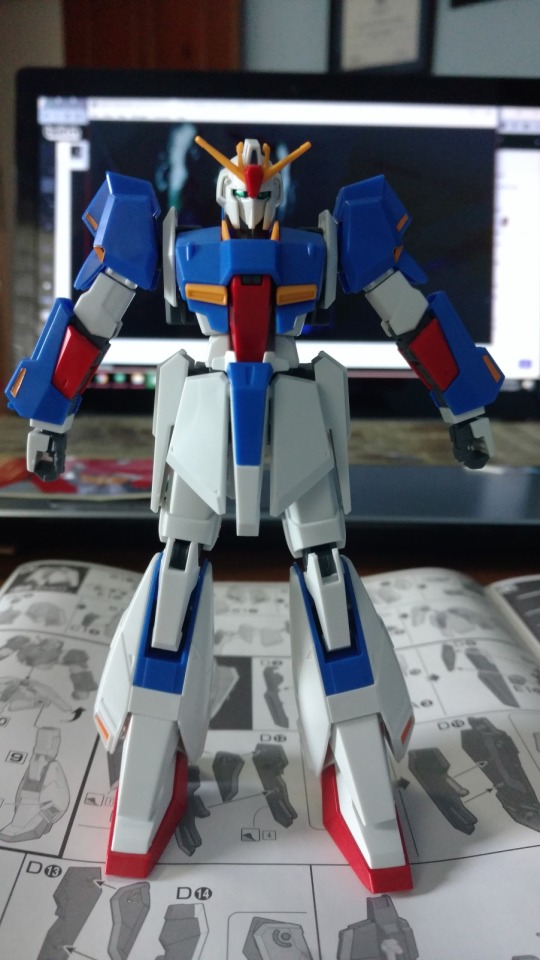
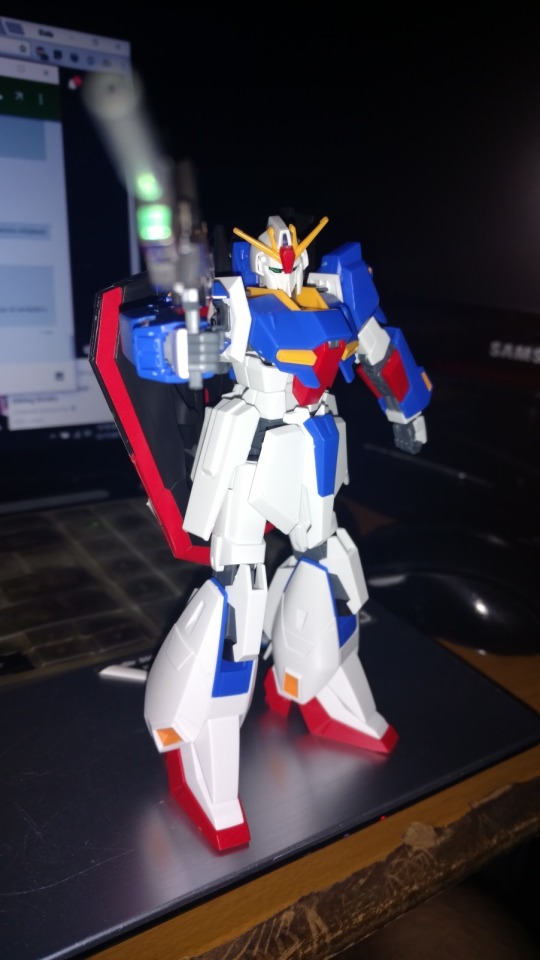
#gundam#mobile suit zeta gundam#zeta gundam#gunpla#high grade#universal century#high grade universal century#hguc#plastic models
0 notes
Text
Quick thoughts on Yoshi’s Wooly World
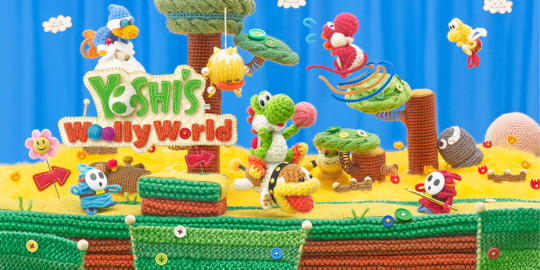
My Wii U still refuses to go into a shelve and as a consequence of that I found myself playing this game. Also, after finishing Dark Souls for the first time only a few days ago I though that this, along with the excellent SteamWorld Heist, would be a great change of pace before diving into Dark Souls II.
Anyway, even though this game didn’t particularly blew me away, I’m glad I took the time to finally give it a shot. I wasn’t really compelled to 100% it, like a normally do these kinds of games, but still, it was fun enough that I saw it till the end credits.
Yoshi’s Wooly World is a pretty fun platformer. It starts very much on the easier side but after close to half of the game, things start getting more challenging.
The immediate catch for this game though, is the visual style. Much like Kirby’s Epic Yarn before it, this game looks beautiful and unique with this real world fabric look. Only Yoshi, I think, completely nails it and feels even more at home with this visual style than Kirby ever did. Everything from the characters to the levels to the backgrounds are made of real world materials. They are mostly fabrics and yarn but there’s also plastic elements and the ever present crystal-like beads.
With this and the new upcoming game for Switch, it seems like Nintendo is using Yoshi as the experimental mascot now that Kirby has gone into a more consistent classic style of games for the last few years.
That said, the game feels experimental only as far a visual design goes. The game’s mechanics, level design and overall structure and progression feel pretty much identical to classic Yoshi games like Yoshi’s Island. Which is not a bad thing by any means, Yoshi’s Island is great.
At the end of the day, this game is just your standard platformer with tight controls and good level design. The one thing that sets it apart is some of the levels which are more exploration based. These are some levels that are not your classic linear affair but are more expansive and intricately designed and lend themselves better for exploration.
Nothing revolutionary, just a solid, fun platformer with a unique look.
Now back to Souls.
4 notes
·
View notes
Text
SteamWorld Heist

In a nutshell, SteamWorld Heist is a 2D, side-scrolling, turn based strategy game where you are the captain of a crew of smugglers/pirates turned heroes that begin on the wrong side of the law and end up fighting for the little guy and saving the world from an enemy that threatens to destroy all there is.
Art Direction
The first aspect that really pops once you start playing this game is how beautiful it looks. I wouldn’t say that it’s technically impressive but the art direction is just amazing. It’s hard to explain but it works really well in setting the vibe for this western-inspired cowboy space opera.
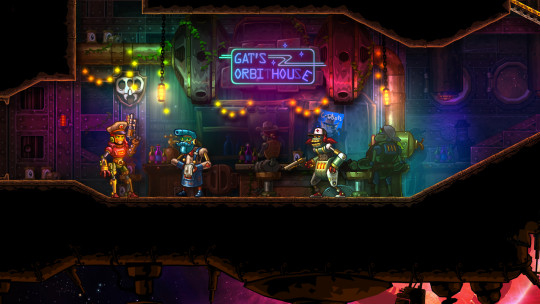
Cozy
The soundtrack is also great. The sound design in general does a great job in setting the tone of whatever activity you’re doing at the moment, whether it’s pulling a heist on an enemy ship or chilling out in a store stocking up on items. Specially nice are the fully vocalized songs that play in the backgrounds of the various bars.
Game Mechanics
As I mentioned before, the game revolves around a very fun and unique turn based strategy gameplay. You progress through the game by beating several levels in which the main objective most of the time is to steal the goodies from the ship you’re heisting at the moment. In each turn, you’re supposed to move around to position your crew members and then either shoot at the enemies, use a character’s skill, collect goodies or destroy, or otherwise interact, with various objectives. The levels themselves are designed with several rooms which are initially completely obscured but are revealed as you enter them. They vary from simpler to more intricate and are full of stairs, cover, vantage points and explosive elements.
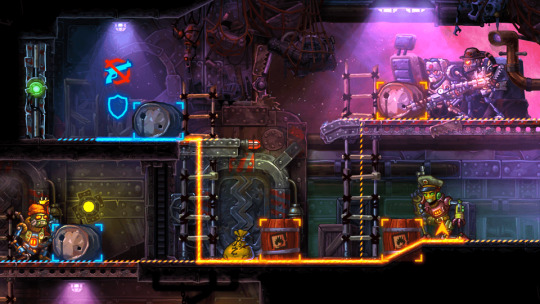
So many options
The game is structured in levels. The vast majority of the levels are enemy ships where your objective is to relieve them of their valuables and run away rather than just destroying all opposing forces. Hence the titular “Heist”. Along the way, various survival missions (where you need to fend off enemies and escape after a given number of turns) and boss battles (where you fight one or more particularly tough enemies) are sprinkled throughout to add to the game’s variety. Also, there are some “levels” that are just shops or bars where you can stop by to buy some items with your stolen hard earned cash, recruit crew members, learn some gossip and progress on the story. By the way, the currency in this world is gallons of water. Which makes sense as a commodity given the fact that the earth is destroyed. Pretty neat world building detail.

So many levels
There are five difficulty levels, of which I played the default one: Experienced. I found this difficulty level to be just right. You can’t go in guns blazing into missions but there’s some chance for mistakes. It’s not a walk in the park but if you pay attention and play carefully you’re not gonna have too much trouble. I died only a few times and even then I was always able to come right back with better loadouts and strategies and was able to succeed. I can definitely see this game getting pretty brutal on the higher difficulty levels.
Speaking about loadouts, before each level, you are prompted to set it up. When choosing a loadout, what you do is select which crew members you will take with you for the upcoming mission as well as choosing their weapons and equipment.
I really like the variety here. Not only with the many different crew members who each have their own unique skills but also the various types of weapons and items. There are several types of weapons: handguns, shotguns, snipers, etc. There are also a bunch of guns within each type that you acquire via looting or buying them from in-game shops as you progress through the game. Some are just the regular point-and-shoot kind of deal while others have special effects and behaviors. From one shot to double shot to piercing bullets to explosive.
There’s great variety in equipment items as well, from armor to speed boosters to grenades to damage enhancers. There’s a lot to choose from, which is great because it translates to great flexibility while assembling your party and planing your strategy for taking on the missions.
Also, there’s hats. These are only cosmetic but you put them in your character and they look very cool. The hats are also an outlet for the developer’s sense of humor since many of them reference pop culture icons like Cloud Strife or Ash Ketchum.
The World
Another thing that I adore about this game is how much personality it has. The crew members are a colorful bunch. I stuck with just a few of them which were the ones that I played the most and ended up leveling to the max level (10). Each added a unique set of skills to the party.
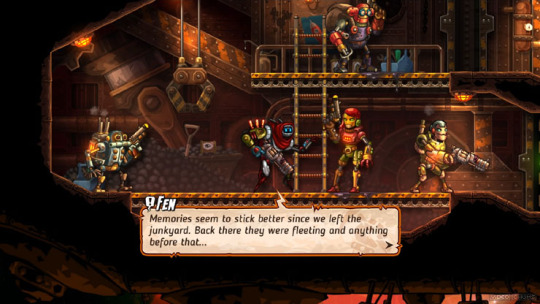
What a motley crew
I also like how it takes the time to build a world and yet it does not drown the player in too much exposition. Some things are just mentioned and others are inferred by the backgrounds in the levels for example. All the events that transpire feel like part of a bigger, full fledged world. I won’t discuss this further to avoid potential spoilers but some of the things that you see or hear are never explicitly addressed in the game and left to interpretation, imagination and mystery.
Simply put, this game has good vibes. The characters and the story are both very charming but what takes everything to the next level is the underlying lore that ties everything together by telling you tidbits about the history and inner workings of this world. To be honest, there’s not much here, but what is there serves to flesh out the world very effectively. For example the fact that robots “grow” by swapping parts and can have “children” by constructing new robots using parts from the mother and the father. I love stuff like that. This is information that the player learns not because of exposition or cut-scenes but through conversations with the various crew members.
So yeah, I really like SteamWorld Heist. Pretty fun game with gorgeous visual and sound design that presents a cool story and charming characters taking place in a world with it’s own rules. I dig it.
0 notes
Text
Dark Souls: The new generation of Metroidvanias

My first experience with Dark Souls was a few years ago when I tried to play it. I say try because, at that time, I got my ass handed to me so bad, close to the beginning of the game, that I couldn’t bring myself to continue. So I gave up and put it right back into my backlog.
Recently though, I decided to give it another shot. I’m glad I did. Not only was I able to overcome the obstacle that, a few years ago, had driven me away from the game, but I also was pleasantly surprised to find a great game that I really enjoyed and found straight up addicting. To me, this game feels like what Symphony of The Night would be if it was a 3D game. Just a lot harder and with a much more cryptic story. Let me explain.
There are some key design elements that I feel like were taken directly from 2D Metroidvanias into this game. It mainly comes down to level design and character progression.
Dark Souls is like a Metroidvania in that...
- The main thing is that Dark souls has a big, expansive world made out of intricately interconnected areas.
- The entire world is not accessible from the get go. You have to collect items in order to gain access to new areas.
- Each area has it’s own boss.
- It’s got RPG elements. We’ve got character progression through experience (leveling up) and buying/finding new armor and weapons.
Dark Souls is different than a Metroidvania in that...
- Instead of traversal-focused skills and abilities serving to access new areas, in Dark Souls we’ve just got keys.
- There’s no mini-map.
Regardless, there’s a lot to love in Dark Souls...
The world is so expertly designed with intricate maps and shortcuts. This is the part I like the most about Dark Souls, and it’s also the part that mostly resembles a Metroidvania.
This game plays great. Combat is engaging and hard. Every enemy is like a puzzle where you need to find the best strategy that takes advantages of your character’s strengths and the enemy’s weaknesses in order to succeed. It all comes together thanks to the awesome, tight controls. This is specially great because even in such an unforgiving game, when you die, you don’t think is was unfair, you think you could’ve done it if you had played better.
I also like the fact that there are many different types of weapons and classes that all play differently. This is a staple in RPGs. However, the fact that this game is an Action RPG makes it so that the weapon/class choice more greatly affects your approach to the game and how you play.
For example, It’s pretty easy to figure out that a mage would play completely different from a warrior. It’s not so obvious though, to think how differently a dexterity based curved sword user would play like as compared to a strength based straight sword user. The move sets are different which means you’ve got slightly different tools for dealing with enemies.
Add that to the fact that there are three different armor weight classes which affect how fast you move and dodge as well as how much defense you have. You’ve also got two separate weapon equipment slots (one for each hand) so, at any given time, you can choose to use a sword and a shield, a two handed weapon or dual wield.
This means that there can be many different strategies to deal with enemies. Each character, depending on it’s build, will favor some strategies over other ones. Is it better to block and attack once the opportunity comes? Is it better to dodge and position yourself in the best spot for a back stab? Is it better to tank some of the damage and charge through? Do you fight head on or use the environment to your advantage? Do you run away and attack from long range using arrows, magic and the like? It all depends on the situation at hand and the character that you’ve built, which ultimately is reflects your own play style.
One aspect of the game that I didn’t enjoy as much was the delivery of the story. This game takes more of a lore based approach to its storytelling rather than doing exposition through cut-scenes. You get the story bits through cryptic character dialog, item descriptions and narration (only at the beginning of the game). Not nearly enough since the game seems to make an effort to make things hard to follow. I understand the direction they were going for with the story but I really prefer more straightforward storytelling. I like the story of my RPGs to pull me in big time. In this game, the story is pretty scarce. The excellent gameplay, atmosphere and challenge, however, where the things that kept me coming for more. The story itself, which I found out more about after reading online, and not from the game, is actually pretty interesting. It’s a shame they didn’t bother to tell it in a way that was compelling or, even, understandable.
Another thing I did not care much about was the implementation of the point of no return. Basically, once you kill the final boss, you’re forced to go into New Game +. You can’t go back to collect any stuff that you missed. Which is more aggravating because of how the game is structured: there are whole areas that are actually hidden secrets and completely optional. So, if you want to see all the game has to offer but you missed something during your play-through, you’re forced to start the game again. Which sucks because you just finished a pretty hard game and you don’t necessarily want to play through it again right away. It’d be better if they just let you go back whenever you’d like. To be fair, The point of no return comes pretty late, it only happens when you kill the final boss. I only wish the game would tell you about it before hand so that you knew what you were getting into.
All in all, I waited too long to play this. There are some things that I didn’t like a lot but the good parts easily outweigh those gripes. I really like this game and am looking forward to playing through the sequels.
#dark souls#metroidvania#video games#videogames#rpg#action rpg#gaming backlog#points of no return suck in rpgs
0 notes
Text
2016's Doom is even better on the second play through
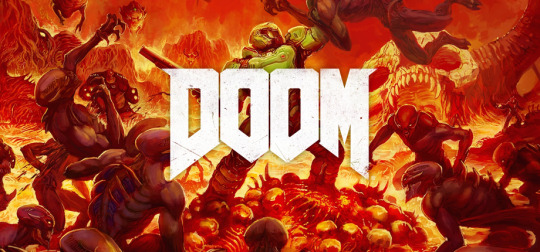
I looked with horror into my PC's screen when, after trying to load my game, Doom said to me that the file was corrupted and it could not be loaded.
I immediately took to the internet in hopes of finding some solution but couldn't find any. I was devastated.

I felt like this poor guy
I had already finished the game and was looking for some quick, uncompromised demon killing action but my computer decided to start acting up (PC master race!). When loading the game, I was able to play for but a few seconds and the PC would freeze. I restarted a few times but always got the same result: freeze after freeze after freeze. Until, apparently, Doom had had enough. One of those crashes seemed to have messed up my save file. That was it, so much for that uncompromised demon killing action. It wouldn't be happening at that time.
Then, after a couple of days trying to come to terms with my loss, my PC decided to work again (PC master race!!). I still craved some Doom so I said to myself: "well, fuck it". I booted the game and started from the beginning. It would be my second playthough. I normally don't do that because of my ever growing backlog. I can't "waste my time" playing something that I already played beginning to end, could I? Yes I could, for Doom I could. The game is just so much fun.
So that I did.
And I'm glad I did it.
While revisiting Doom for the second time I felt something that I had no idea could happen. I was enjoying the game even more than I did during my first playthrough. And I think that's because I made a point of playing differently this time.
Whereas during my first playthrough I stuck to two or three weapons that I really liked, now I was trying everything by trying to max out all of the weapon specific mods. Also, during my first playthrough I pretty much ignored all of the passive character skills (known as runes) while now I was actively trying to complete all of the challenges to unlock all of them.
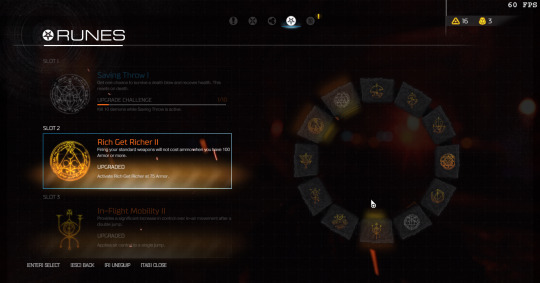
ALL OF THE RUNES
So yeah, I was playing differently, focusing on variety. And I’m having a blast. Even more than I did during my first playthrough. I was particularly fond of the mod that gives you infinite ammo when you have a high shield level combined with the Gatling gun mod that prevented it from overheating. It results in an infinite, continuous stream of bullets shooting out of a three rolling barrel Gatling gun. That’s got to be one of the best feelings in the world.

Hell yeah!
Which is really crazy to me because Doom already is a great game that I had such a great time playing it.
This game is so fun. It has an expertly executed balance of great, fast, break neck pace action and slower, exploration heavy moments. The levels are so large and intricate that they lend themselves perfectly for this kind of gameplay. The fact that all of the weapons feel great to use and are viable and unique in a way that you quickly develop favorites is just the cherry on top.
If I had to fault Doom for anything, that would be the story. The game’s plot is just whatever and the characters are forgettable. It’s just your typical “the-world-is-gonna-end-because-of-an-otherworldly-invasion-that-only-you-can-stop” affair. But the thing is, Doom doesn’t need it’s story to be groundbreaking. It needs it to be nothing more than an excuse for the excellent gameplay. And in this sense, the story serves its purpose. Also, the Doom Marine acts like a complete bad ass that couldn't care less about the other character’s motivations as long as he stops the demon invasion so, in a sense, you could surmise that he himself does not care at all about all of that BS story. That idea is pretty fun to me.
The game is also technically impressive. The graphics are gorgeous and it runs flawlessly at 60 fps, although, since I played it on PC, that is to be expected in this day and age (PC master race!!!). Still, even though technically the game looks good, the early environments can get a little bit dull because there’s not a whole lot of variety there. This definitely gets better as you progress the game though.

The apocalypse looks beautiful
So yeah, I pretty much only have good things to say about Doom. The fact that I liked this game so much the first time around and did so even more the second time is incredible to me. I guess that tells me that this game shines even more when you approach it with a mindset of trying everything and making a point of completing the various challenges that affect the way you play the game.
If you like shooters or action heavy games in general, you owe it to yourself to give this one a shot.
#doom#2016 doom#pc master race#pc woes#video games#first person shooter#fps#completionist playthrough#completionist
2 notes
·
View notes
Text
Gunpla Chapter 1 - High Grade Gundam Mk-II

Thanks to these guys’ Amateur Gundam Construction stream series over on Twitch, I’ve gotten myself into the whole Gundam world. So much so, that I just recently watched the remaster of the original 1979 series, Mobile Suit Gundam. I also watched The 8th MS Team, War in the Pocket and, most recently, Mobile Suit Zeta Gundam.
I really liked those a lot. I was pleasantly surprised to find some pretty deep characters and subject matter.
I was also really intrigued by the actual plastic models. So, the next step in my trip into this fandom was clear: I had to build at least one of those. In fact, I just bought and built my first one a few weeks ago.
I picked the Gundam Mk-II because, well, I really like the design. This Gundam shows up in the Mobile Suit Zeta Gundam series which is a direct sequel to the first one. It is, in my eyes, a better version of the original Gundam. Sort of what it could’ve been. While the original Gundam looked a little bit derpy to me, this one looked cool. The design was still simple and functional but it looked so much better than the original. It’s an evolution and improvement that still keeps the soul of a simple, honest, super sized military robot. I love it.
Anyway, here are some pictures of my first gunpla:

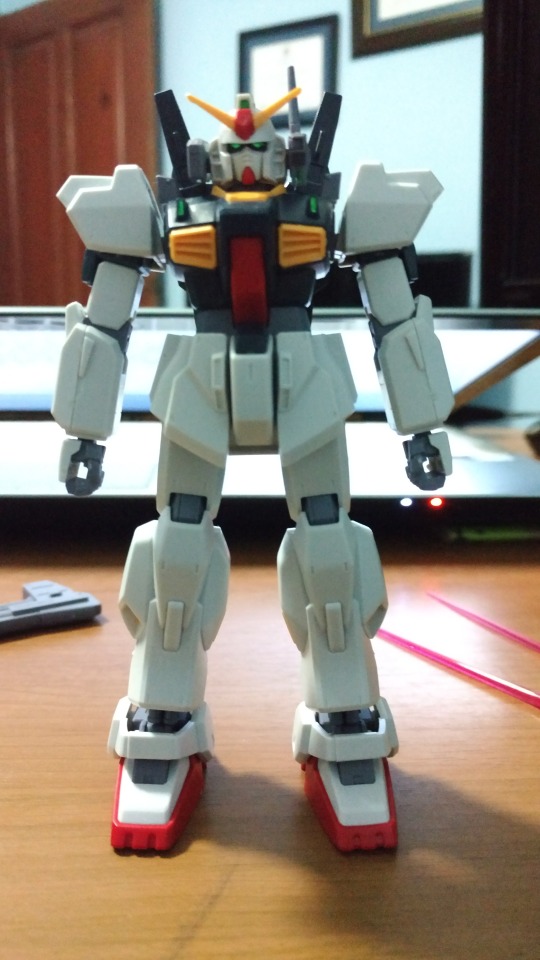


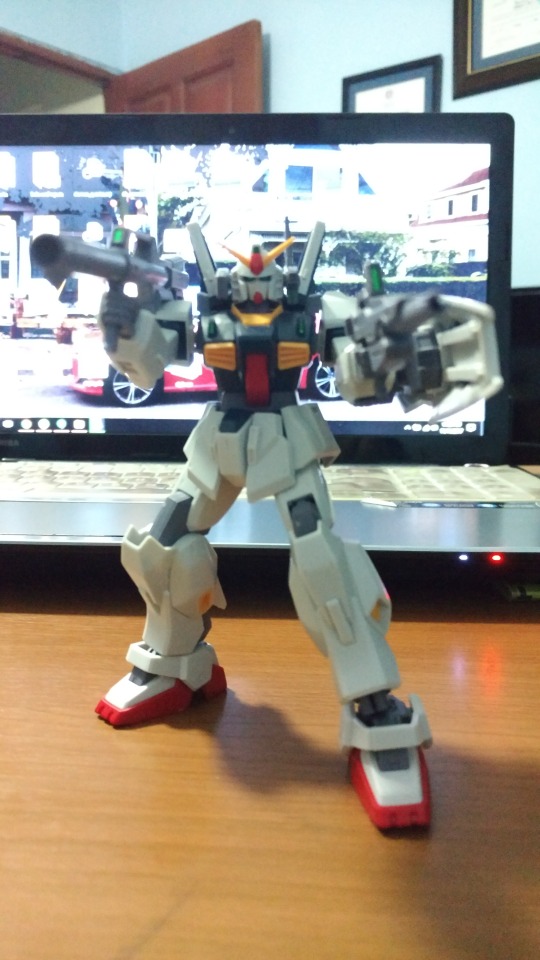
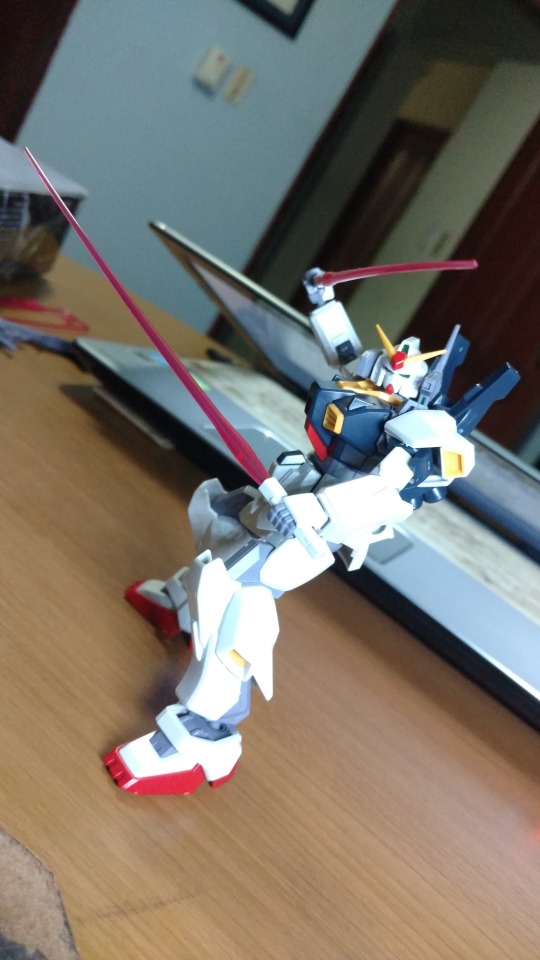
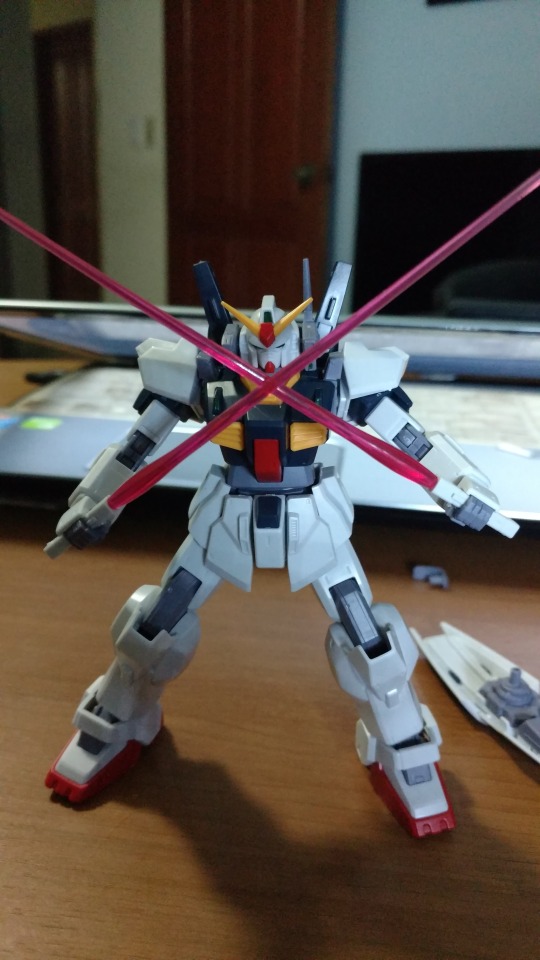
#gundam#mobile suit zeta gundam#gundam mk-ii#rx-178#gunpla#high grade#universal century#high grade universal century#hguc#plastic models#easy allies#easyallies
0 notes
Text
Metroidvania Advanced: Circle of the Moon
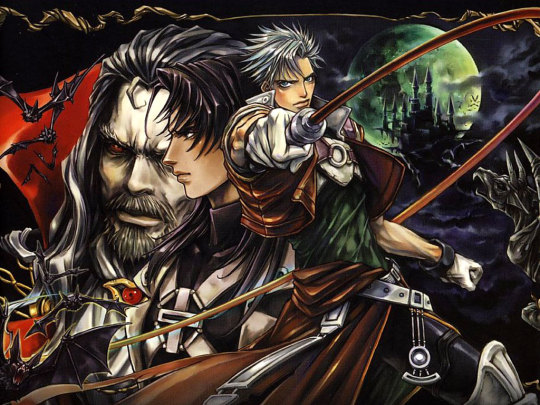
By now, it should be pretty clear that I really love Symphony of the Night. So, it was only natural that I wanted to delve deeper into the series and take a look at the installments that succeeded such a milestone game. And that’s what I did. The next three games in the series continued using the formula established by SotN with only but small tweaks to the surrounding details... With varying degrees of success.
Castlevania: Circle of the Moon
Circle of the Moon is the first Castlevania game to come out after Symphony. It boasted a new castle, a new time period, a new cast of characters with new motivations and backgrounds and the same big bad: Count Dracula himself.
One of the weird aspects of the game is that you don’t play as a Belmont. Instead, you play as a whip wielding vampire hunter named Nathan Graves. Nathan arrives into the cursed castle along with his master, Morris Baldwin, and his son, Hugh Baldwin, who is a fellow apprentice under Morris along with Nathan. Quickly enough, they are greeted by Dracula, who has just been resurrected thanks to Camilla, one of his minions.

So it begins.
It turns out that the good Count is yet to regain his full strength and, to do that, he needs a human sacrifice and figures Morris would do just fine. So, a trap is triggered that makes the floor where Nathan and Hugh are standing, crumble under their feet and they get plunged into the depths of the castle. Now separated from their master, they start their quest to rescue him, kill Dracula and flee the castle. Only you, as Nathan, have to do it alone because Hugh is having some daddy issues.
And with this setup, the game begins. Overall, the scenario is nothing to write home about but still serves as a competent motive to the characters.
Gameplay wise, the game is very similar to it’s predecessor. You are thrown head first into a inhospitable dungeon that you need to explore in order to become stronger, defeat common enemies and bosses and work your way up to the final encounter with Dracula.
The moment that you touch the controls however, you start noticing the differences. Controlling Nathan is nothing like controlling Alucard in SotN. Yes, you still walk and run and jump and attack, but everything feels heavier and slower and stiffer. It feels as if the developers were trying to go for a more classic Castlevania feel, the kind of stuff that you would find in games like Rondo of Blood or Dracula’s Curse. In my opinion, a bad choice. It felt like a step backwards for the series really.
Another thing that contributed to this stiffness in the controls, I think, is the fact that they did away with the multiple types weapons that Alucard was able to use in favor of just the whip. Not saying that they couldn’t have implemented the whip in a more fast, dynamic way, but they choose not to, furthering the theme of taking more inspiration from the classic games. This choice did, however, negatively affect the game’s gameplay variety for sure.
In terms of game systems, Circle and Symphony are pretty similar. You gain experience by killing monsters, uncover abilities that help with traversal, and obtain equipment that improve your stats. The main difference lies in the DSS or Dual Set-up System which replaced the “Skills” from SotN. The DSS consists of two sets of cards: The Action set and the Attribute set. These cards are obtained as you progress through the game and the idea is that you can equip a pair of cards at any given time, one from each set. Each combination grants a special effect, from elemental damage and stats increase to whip length and health recovery. There are ten cards in each set. That means a total of a hundred possible effects. Pretty cool stuff. It’s actually pretty fun to experiment with different combinations as you obtain more and more cards.

The cards’ pictures are nonsense but the effects are pretty cool.
The castle itself is still a lot of fun to explore. It’s varied and although there’s no Inverted Castle or any other castle gimmick, it’s pretty expansive still. The only critique that I have on the level design is that it feels a little bit simpler and the general layout of some areas gets repeated sometimes. Things like long corridors or multilevel staircase like towers appear a little bit too often. This is something that never happened in Symphony of the Night, where every new area felt fresh and unique both visually and structurally.
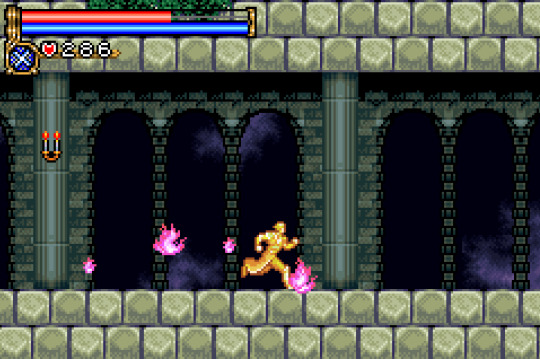
“I swear I’ve run through this corridor before.”
Graphically, I’d say the game looks pretty good. Again, the enemy, characters and environment design looks a bit simpler and more cartoonish than its predecessor but that’s not necessarily a bad thing. Even though I personally prefer the look and feel of SotN, Circle of the Moon is not a bad looking game by any means. Every object looks great and clear on screen and the colors are vibrant.
The sound design is also pretty good. The quality is not up there with Symphony but that’s to be expected since this the developers had much more to work with in the PlayStation as compared to the Game Boy Advance. Still, the game sounds pretty good and the melodies are catchy, entertaining and do a good job of putting you in the mood for some vampire hunting.
Overall, the main critique that I have on Circle of the Moon is the controls which, even though they don’t feel as good as Symphony’s, are still usable and make for a fun game. I think Circle of the Moon is a worthy successor to the masterpiece that is Symphony of the Night. Even though it doesn’t reach the greatness of its predecessor, it’s still a great addition to the series which, thanks to the new ideas that implements and it’s addictive and fun gameplay, is not only good as a handheld game but as an any-platform game on its own right.
#castlevania#circle of the moon#cotm#symphony of the night#sotn#metroidvania#video games#retro gaming#game boy advance
1 note
·
View note
Text
Samus is back

I’m most of the time consumed by my backlog and because of that I almost never play games at launch. Only very few special cases make me drop whatever I’m playing at the moment and dig in immediately upon release. Metroid is one of them.
Ever since Nintendo dropped the bomb that not only one but two brand new Metroid games were coming out I’ve been looking forward to this. I loved the fact that it was going to be a Metroid II remake too since that’s one that I could never bring myself to play. So, much like Zero Mission before it, Metroid: Samus Returns was going to be the perfect chance to play an older game which today is just not accessible.
So yeah, now that I’ve finished the game I can say that I really liked it. I would’t say it’s up there with the legendary Super Metroid or the revolutionary Metroid Prime but it is still a great addition to the series and worthy of the Metroid name. As a remake, I’d say it renders the original obsolete (although AM2R is still very much worth playing).
I’d say the best thing about this game is how it feels. I thought that by making it 3D it would feel slow and clunky and floaty. I couldn't have been more wrong. This game feels tight, fast, agile. I love it. This is an action game through and through. The movement feels great as well as the combat. It’s exhilarating when you’re surrounded by several enemies and you need to dispatch them by dodging, jumping and shooting all over the place. The counter is a great part of that dynamism in the game play. It’s fast and it gives you a fair advantage if you can pull it off. The fact that it actually takes some skill to perform is what makes it truly something special. It’s just so fun to do and it feels great.
Another mayor gameplay addition, the 360 degree aiming, is something that I also was concerned about. After all, you do need to stay stationary in order to aim so I was worried that it would feel, again, slow and boring. Not the case. Once I got used to it I feel like I don’t know how I even played Metroid games before without it. It quickly became second nature.
The other gameplay additions, the Aeion abilities are also great fun. Again, these were ones that I was skeptical about. I was worried they would be tacked on and inconsequential. Wrong again, I found them to be very well implemented. They are a ton of fun and have a ton of uses throughout the game. Both to solve puzzles and for combat. I specially like the shield one, which I would use whenever I found myself low on health during a boss fight.
That last one brings me to my other point: this game is hard. Like, old school hard. I did use that shield ability a lot because I was low on health a lot. It’s hard and yet, it never becomes frustrating. I think this is because the fact that the game controls so well that one never feels cheated or that the game is being unfair. It’s really fun to get crushed by some enemies while learning their patterns only to later exploit their weaknesses and finally succeed. It’s great that the checkpoint system is so generous as to respawn you right before where you last met your demise. That’s a great balance of challenge and convenience.

Samus is such a pro! After 250000 gazillion Metroids she still gives it her best.
Talking about combat, most of the bosses in the game are the titular Metroids. After all, the reason why Samus is in SR388 is to exterminate them. This is the central plot point in the game but it doesn’t translate too well gameplaywise. It’s, in my opinion, the game’s greatest weakness. And by “greatest weakness” I really mean “blemish in an otherwise masterful game”. The problem with these boss fights is that they are forty and there are only four variations of Metroids. This means that you end up fighting the same enemy so many times that it becomes somewhat repetitive.
I still had fun with them, but after five or more times killing the same type of Metroid, things start to get old. I would’ve really liked them to mix things up a bit. They could maybe have introduced at least one new Metroid evolution to the game or even have a few more enemy AI variants for the existing types. Or include more non-Metroid type bosses. It feels like they missed an opportunity to really make the remake shine. And it’s not like there’s no new original content but I think just a little bit more would’ve gone a long way in making the game more varied and fun.
To be fair, there are a few Metroid battles that do introduce a new game mechanic in which, after enduring a certain amount of damage, the Metroids would run away and you’d have to hunt them down. This did add some much needed variety and made these fights more engaging but still, among so many repeated boss battles I fell like that wasn’t enough. A step in the right direction definitely but not enough.
At the other end of the spectrum is something that the game nails: Presentation. This game looks gorgeous. And with the 3D slider on I think is one of the best looking 3DS titles. This is an example of a game where the stereoscopic 3D feature does truly add a lot to the game. The backgrounds just pop to life thanks to the added visual depth. Special effects like shattering ice jumps at you from the screen. Truly a spectacle.
I also love how there’s all sorts of creatures in the background. These are SR388 natives which are not actually enemies in the game. They are just there. Their purpose is not for you to interact with them, but to paint a picture. A picture of a planet that is living and breathing. That you/Samus are/is just passing by and navigating through this vibrant ecosystem that actually exists and has existed before you got there and will continue to exist after you leave. These are the kinds of details that I love because they make the world believable.
Another form of eye candy comes in the form of the melee counter. While countering a regular enemy will just knock them back into a dizzy state, countering a boss is a whole different story. Countering a boss will trigger a sort of cut-scene where you see Samus pulling off some serious moves against the boss in question. You don’t lose total control while this is happening as you need to make sure that you keep attacking constantly with missiles or otherwise. These counter animations are sweet, dynamic and action heavy. It feels like they took inspiration from Other M when designing these. They look great and give you a considerable advantage by scoring some free hits on the boss. Countering a boss is harder that countering enemies though so in trying to take the chance to dish out some serious damage through the counter, you can end up getting hit yourself if your timing is off. It’s an awesome risk vs reward situation that actually takes some skill to get advantage of.
So yeah, Metroid: Samus Returns is a great game and really like it. It’s not without it’s flaws but I don’t think they detract too much from the experience. It’s a great time to be alive. Cool, powerful and bad ass Metroid-murder-machine bounty hunter Samus Aran is back and age hasn't slowed her down a bit.
Now please say something about Prime 4, Nintendo...
3 notes
·
View notes
Text
A few other reasons why I love Castlevania: Symphony of The Night
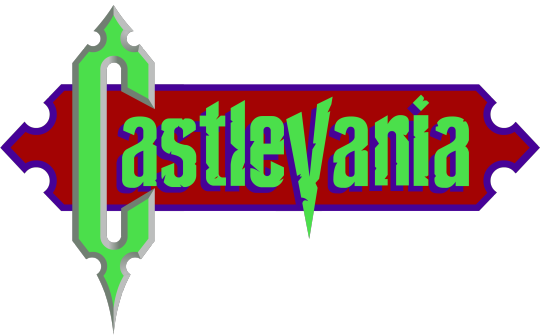
The devil vampire is in the details
I really love to find little details in games that developers put there seemingly for no real reason. The ones that feel like the developers are just having fun. I find them fun too. This is particularly true in Symphony of The Night where such details show up in various occasions and, to me, serve to flesh out the world but also to add mystery to it.

Well that’s weird.
For example, what’s up with that room with the confession booth? When I first got there I was pretty curious as to what the purpose of this room could be. I noticed the chairs and got close. Using video games’ universal control for interacting with background elements, the UP directional button, I managed to sit down into one of these chairs and, much to my surprise, a ghost priest shows up! He comes up, sits in the opposite chair and crosses himself. Short after that he disappears. What? What just happened here? Did Alucard just make a confession? This is clearly a haunted confession booth? We are in a demon’s castle after all. But why would Dracula have a christian church in his castle? Just to mess with our minds as vampire hunters? What is this?
Well that was weird and hilarious and creepy all at the same time. Then I go and sit in the chair where the ghost priest was before. Now a ghost lady appears! She sits in the opposite chair, cleans her cheeks as if crying because of her confession, and then disappears. What the hell? I’m laughing out loud at this point.
I’m still curious so I sit in the woman’s chair again. Nothing happens. Huh. I get out of the room and enter again and sit in the confession chair again. Now the ghost priest appears again, but this time he laughs, has red eyes and closes the curtain on his side of the booth. Lol what? Then, suddenly, a group of swords and axes come out of the priest’s side of the booth with the intent of stabbing Alucard through the booth’s middle wood wall!!
I love this.

WTF!
Why would the developers put this in the game? The game would’ve been perfectly fine without that. It doesn't serve the plot in any way. It has no game play mechanic implication. Nothing, it’s just there.
It does however add mystery to the castle, to this game’s world. It gives the player the sense that this is a place rigged to kill you, full of traps and deceit where you should feel uneasy. That familiar things will hurt you and that something that looks safe most likely is not. This place is haunted, it is truly a demon’s dungeon.
Well done guys.
I love that confession booth room because it tells a lot about the developers’ intent with the world that they were creating.
There are other details such as this. There’s the rat that you see through the walls of the castle. Of course there’d be rats here. It makes sense. Skeletons hanging from the ledges in the outside walls. That part in the caves where you move a box into a position that blocks some water flow and that ends up trapping and subsequently drowning a couple of armored lance goons. This is a dangerous place, even for hell’s legions.

I’m so sorry guys... I swear I didn’t mean it.
All of these details, taken on their own are not as powerful as when you consider them together. As pieces of a real place, a world that exists. A world that has meaning and purpose where stuff happens outside of what you see as a player. They make it believable. They make a tow-dimensional castle from the middle ages that is full of demons being raided by a single vampire-human-hybrid-dude something believable.
These things add charm and heart to the game.
Other cool stuff
Symphony of The Night’s world is expertly crafted. Exploring Dracula’s castle in this game is so addicting and fun. A true joy. It feels like it makes sense while also offering surprising discoveries. And if that wasn’t enough, when you think you finished the game, you actually figure out that was only half of it. Oh hello, Inverted castle!
Spells are not locked away, you just don’t know how to perform them. You can go to the library and learn the button combinations to perform the spells by purchasing them. However, what you’re purchasing is knowledge, not the spells themselves. Alucard already has the capability of doing them he (you) just doesn’t know how. They are not locked, they are always available. If you know the button combination, you can perform them without needing to buy the “recipe” from the vendor. I really like this because it conveys the fact that those are Alucard’s latent abilities, they are just hidden within him and, with a little experimentation, you can stumble upon them.
You start powerful, then, soon after the very beginning, get weak. Then you play through the game and get gradually more powerful until to surpass how strong you were at the beginning. I love the sense of progression. There’s progression through leveling up, through meaningful pickups in items and weapons and through discovering more and more of the castle and its secrets. The fact that you start the game so powerful gives you an idea of the kind of potential that you can achieve and it feels pretty damn good once yo reach and surpass your former might.
And last but not least, you play as a bad ass stylish vampire. Alucard is just a cool character to look at and to play as. That’s all.
#Castlevania#SotN#castlevania SOTN#symphony of the night#gaming#retro gaming#video games#retrogaming#videogames#ilovethisgame#secrets#metroidvania
16 notes
·
View notes